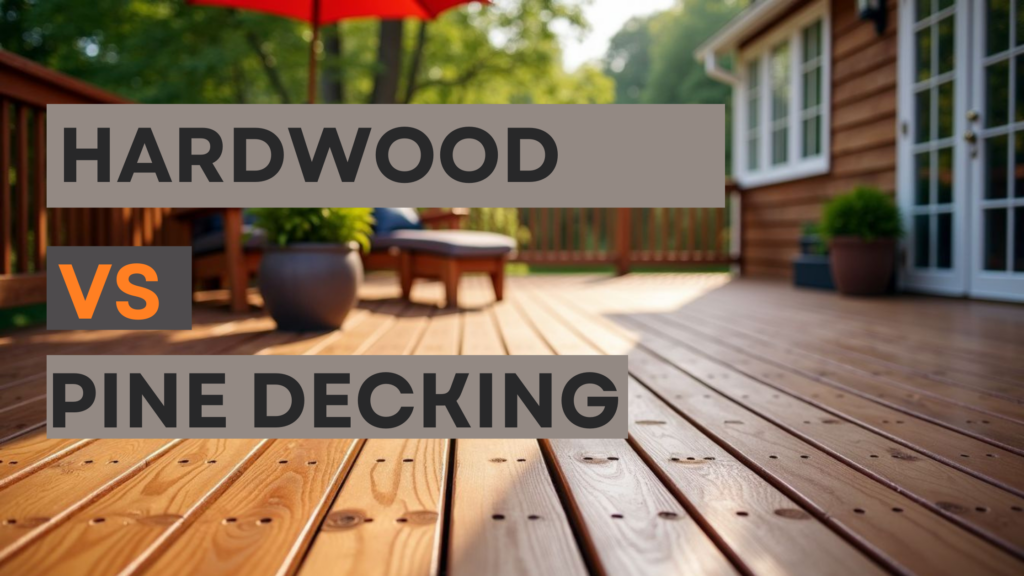Hardwood vs Pine Decking
Choosing the right material for your deck build is a significant choice. Some people might favour pine decking due to its affordability and stain absorption abilities. This article will steer you through the strengths and weaknesses of hardwood versus pine in decking, accentuating durability, maintenance, design, affordability, and environmental impact.
Continue reading to discover the option most suitable for your outdoor area.
Overview of Decking Materials
Decking materials, such as hardwood and pine, offer different characteristics for outdoor surfaces.
Hardwood decking presents durability and aesthetic variety, while pine decking tends to be more susceptible to damage and has limited design options.
Hardwood Decking
Hardwood decking comes from trees like Kwila and Garapa. These woods are famous for lasting up to 25 years with good care. They naturally fight off decay and insects, which makes them perfect for outdoor spaces.
Unlike other materials, hardwoods require less upkeep over time. With varieties such as Mahogany, homeowners have plenty of choices for a high-end look.
Kwila and Garapa decks stand the test of time against elements.
Mahogany is on the pricier side but offers unmatched durability and stability. Opting for hardwood decking means investing in beauty that lasts decades with minimal maintenance needs.
This choice supports sustainability efforts too since many hardwoods are sourced from forests managed responsibly.
Pine Decking
Shifting focus from hardwood, Pine decking offers a different set of benefits and considerations. People choose treated radiata Pine for their decks because it lasts between 15 to 25 years with good care.
Its affordability makes it an attractive option for those on a budget. Treated Pine comes in grades like H3, suitable for above ground use, and H4, which can directly contact the ground.
This grading system shows that Pine undergoes chemical treatments to boost its durability against outdoor elements.
Working with Pine is easy due to its soft nature, making it a favourite among DIY enthusiasts and professionals alike. Despite this ease of handling, users must maintain Pine decking regularly to preserve its condition over time.
The treatments help protect the wood from rot, insects, and decay but also mean that environmental concerns arise regarding these chemical processes. As such, considering the sustainability and environmental impact is crucial when opting for treated timber options like Pine decking.
Durability and Longevity
In the world of decking, durability and longevity are essential. Hardwood decking offers high resistance to wear and tear, while Pine decking is prone to damage over time.
Hardwood resistance to wear and tear
Hardwoods like Kwila, Mahogany, and Purple Heart show great resistance to decay, termites, and fungi. Their strong nature helps them fight off wear and tear better than other materials.
For example, Kwila decking does not easily give in to decay. It stays solid over years of use.
Mahogany and Purple Heart are also champions in holding their shape and colour against the elements. They resist warping, cracking, and splitting well. This makes them ideal for areas facing harsh weather conditions or heavy foot traffic.
Hardwoods stand the test of time with unmatched durability.
Moving on from their resilience, let’s consider the maintenance hardwood decks require.
Pine’s susceptibility to damage
Pine decking needs a lot of looking after. This type of timber gets dents and scratches easily. It also might warp or split if it doesn’t get the right treatment. People must maintain pine decks regularly to keep them strong.
The need for frequent maintenance ties back to its tendency to suffer from wear and tear. Moving on, let’s talk about how often you’ll need to maintain pine decking compared to hardwood options.
Maintenance Requirements
When maintaining your deck, hardwoods need less frequent upkeep compared to pine decking. This is because they are less prone to damage and wear and tear, making them a more durable choice in decking materials.
Frequency of maintenance for Pine
Pine decking needs care often to stay in good shape. Owners must clean, stain, or oil it regularly to prevent warping and splitting. Treated Pine especially requires this attentive care since it’s less durable than hardwoods.
The process involves checking for damages and making sure the wood stays protected against weather elements.
Maintenance is key to extending the life cycle of pine decking.
This maintenance helps prolong the deck’s life and keeps it looking fresh. On the other hand, hardwood decks demand less upkeep.
Lower maintenance for Hardwoods
Hardwoods stand out for their low upkeep needs. With types such as Kwila and Vitex, these timber decking options can stay in top shape for 25 to 50 years if owners oil them once a year.
This annual oiling helps hardwoods resist weather damage and keeps them looking fresh. Unlike composite decking that also boasts minimal maintenance, hardwoods add natural warmth and beauty with just a bit of care.
The yearly task of oiling does not compare to the frequent maintenance required by other materials like Pine. Owners save time and money in the long run by choosing hardwoods for their decks.
Moving on, let’s explore how these materials offer different aesthetic and design options.
Aesthetic and Design Options
When considering decking, the aesthetic and design options are crucial to achieving the desired look for your outdoor space. The variety in appearances of hardwoods offers a wide range of natural beauty and versatility, enhancing the visual appeal of any deck.
Pine may have aesthetic limitations due to its more uniform appearance compared to the diverse range of looks that can be achieved with hardwoods.
Variety in hardwood appearances
Hardwood decking presents an assortment of colours and textures capable of reviving any outdoors. For instance, Mahogany offers a vibrant reddish-brown colour complemented by stunning grain patterns.
Concurrently, Purple Heart Decking is distinctive for its intense purple shade, granting a unique aesthetic for decks.
Kwila and Garapa are further hardwood choices recognised for their inherent appeal. These timbers contribute both elegance and longevity to decking undertakings. Given this diversity, homeowners possess the liberty to modify their decks inline with individual preference or architectural design.
The appropriate timber can transform any deck into an outdoor spectacle.
Aesthetic limitations of Pine
Shifting from the variety in hardwood appearances, pine decking shows its own character. Pine takes up stain very well, offering many colour choices. Yet, it trails behind hardwoods in design diversity.
This wood’s natural look might not match every outdoor style or taste.
Pine’s use as a decking material faces some critique for its aesthetic range. Treated pine is budget-friendly but lacks the visual qualities of more expensive woods. While recycled materials and forest certification like FSC label promote environmental care, pine treatments raise concerns over their impact on waste and landfills.
Cost Considerations
When comparing hardwood decking to pine, the initial cost is an important factor to consider. Long-term investment value also plays a significant role in this decision-making process.
Initial cost comparison
Choosing the right decking material affects your pocket from the start. Treated radiata pine boards cost between $3 and $10+ per linear metre. This makes them a more affordable option for many people.
On the other hand, imported hardwoods like Kwila range from $8 to $12+ per linear metre. For something even pricier, Vitex planks can exceed $20 per linear metre.
If you are considering composite alternatives, prepare for an even higher initial outlay. These options will set you back between $100 and $200 per square metre. The choice between traditional wood products and composite decking depends not just on appearance but also on your budget at the outset.
Long-term investment value
Moving from the upfront costs, we now consider the long-term investment value of decking materials. Hardwood decking, with its higher initial price tag, offers an impressive lifespan and durability.
This material brings a better return on investment over time because it lasts longer with proper care. For instance, hardwoods can stand up to wear and tear without much maintenance.
Composite decking products like Trex® Transcend come with warranties extending up to 50 years. These options show great value in the long run compared to treated Pine that requires frequent upkeep.
Pine may be cheaper at first but demands more spending on maintenance as years pass by. With hardwood or composite decks, you spend less on upkeep while enjoying their looks and functionality for decades.
Environmental Impact
Hardwoods are sourced from sustainable forests, ensuring minimal impact on the environment. Pine treatments pose environmental concerns due to their potential toxicity and disposal methods.
Sustainability of hardwood sourcing
Sourcing hardwood sustainably is key to reducing its environmental impact. ITI Timspec ensures all Kwila they supply is 100% certified by the Forest Stewardship Council (FSC). This shows their commitment to responsible forest management.
Both FSC and Programme for the Endorsement of Forest Certification (PEFC) set standards for sustainable timber production, proving that it’s possible to enjoy beautiful hardwood decks without harming the planet.
Yet, there are worries about how some mahogany gets sourced, raising questions about sustainability across all hardwood types.
Certifications like those from FSC and PEFC help buyers know their wood comes from forests managed in an eco-friendly way. Timber beats composite materials in sustainability races because it can biodegrade and has a smaller carbon footprint during use and disposal.
With options for recycling and using reclaimed wood, choosing certified hardwood decking lessens environmental harm even more. Let’s now look at concerns with Pine treatments.
Environmental concerns with Pine treatments
Pine decking often needs chemical treatments to make it last longer. These chemicals can harm the environment. People worry about how sustainable these treatments are. They think about the effects on soil and water.
The need for regular upkeep with treated pine adds to its environmental footprint. This includes more use of chemicals over time to prevent damage from the surroundings. The process affects sustainability, unlike options like recycled plastic or PVC decking that have a lesser impact on nature.
Conclusion
Choosing the right decking comes down to what matters most to you. Hardwoods offer strength, less upkeep, and rich design options but cost more upfront. Pine may fit tighter budgets and provides good stain absorption but needs more care to avoid damage.
Think about looks, cost, and how much time you want to spend on maintenance. Your decision will shape your outdoor space for years.
FAQs
1. What are the environmental considerations for hardwood and pine decking?
Both hardwood and pine decking can have environmental certifications, but transportation of the materials and whether they’re recyclable may also factor into their environmental impact.
2. How does treated timber compare to untreated in terms of longevity?
Treated timbers, such as pressure-treated lumber, often last longer than untreated ones due to enhanced resistance against elements like moisture.
3. Does ventilation affect the choice between hardwood and pine decking?
Yes, ventilation is important for both types of wood to prevent moisture build-up which can lead to decay over time.
4. Is there a difference in maintenance between pressure-treated pine and hardwood decking?
Pressure-treated pine usually requires less upkeep compared to some types of hardwoods but it’s always best to check with your supplier about specific care instructions.


